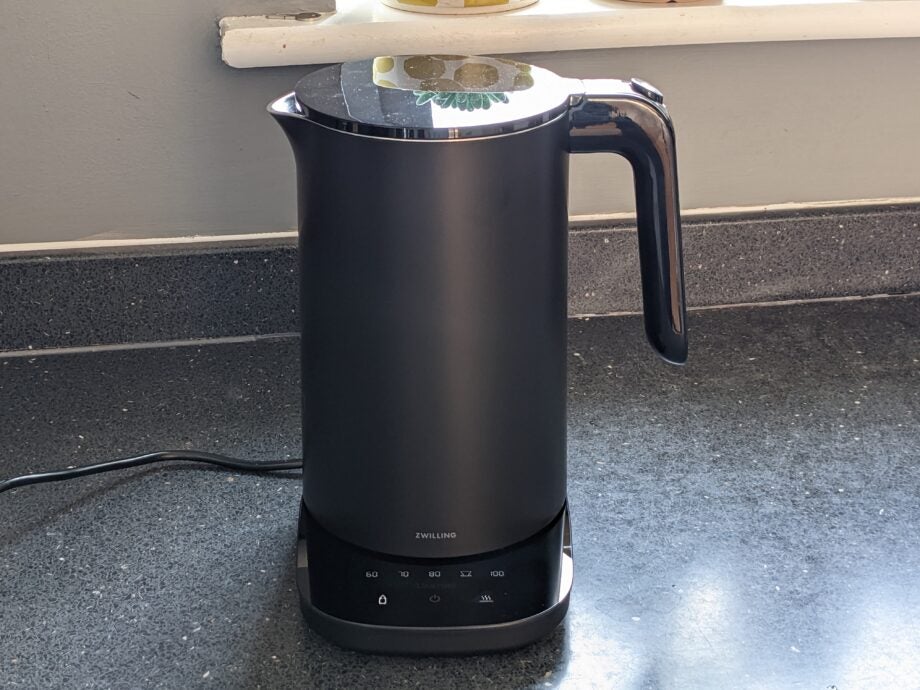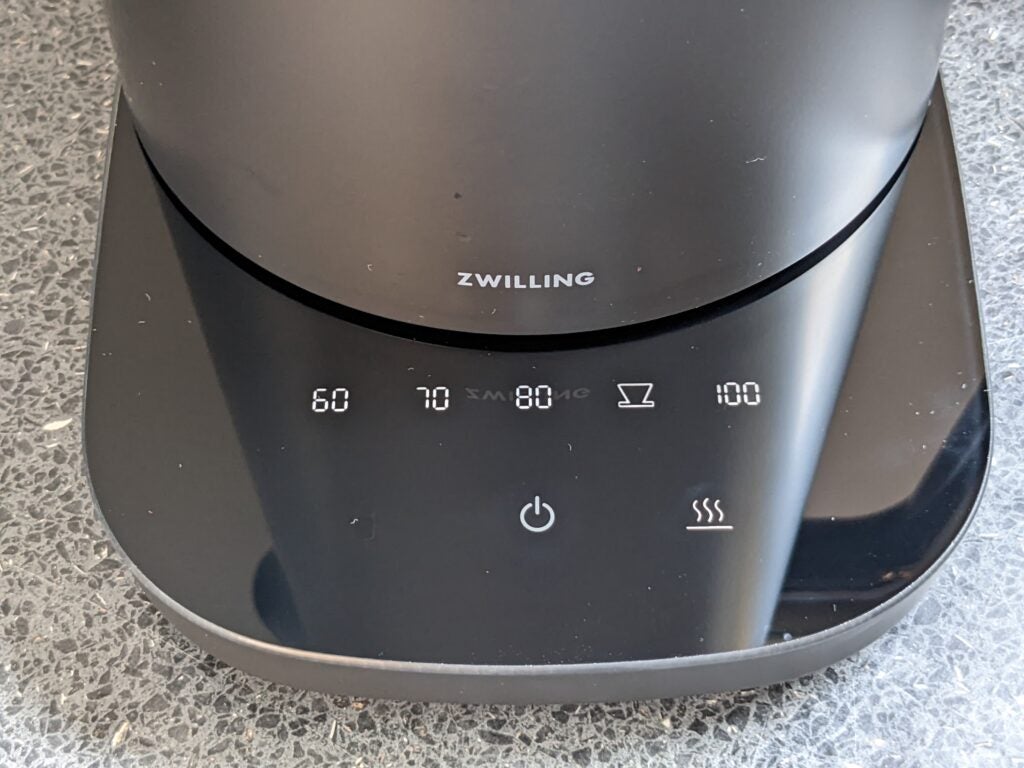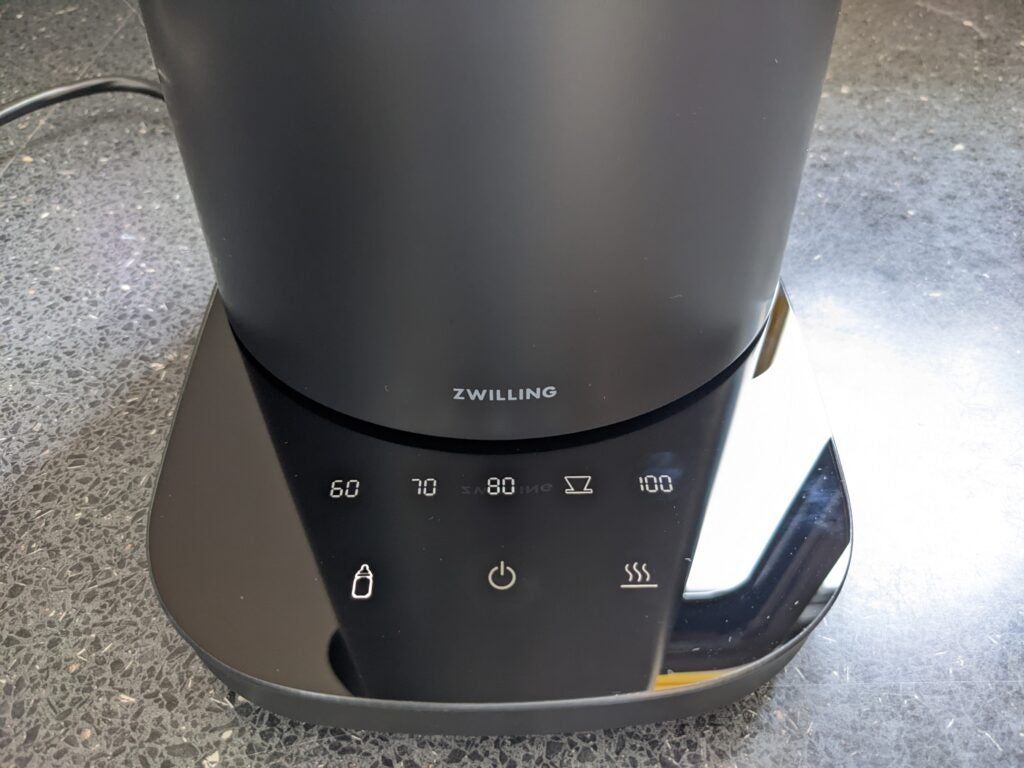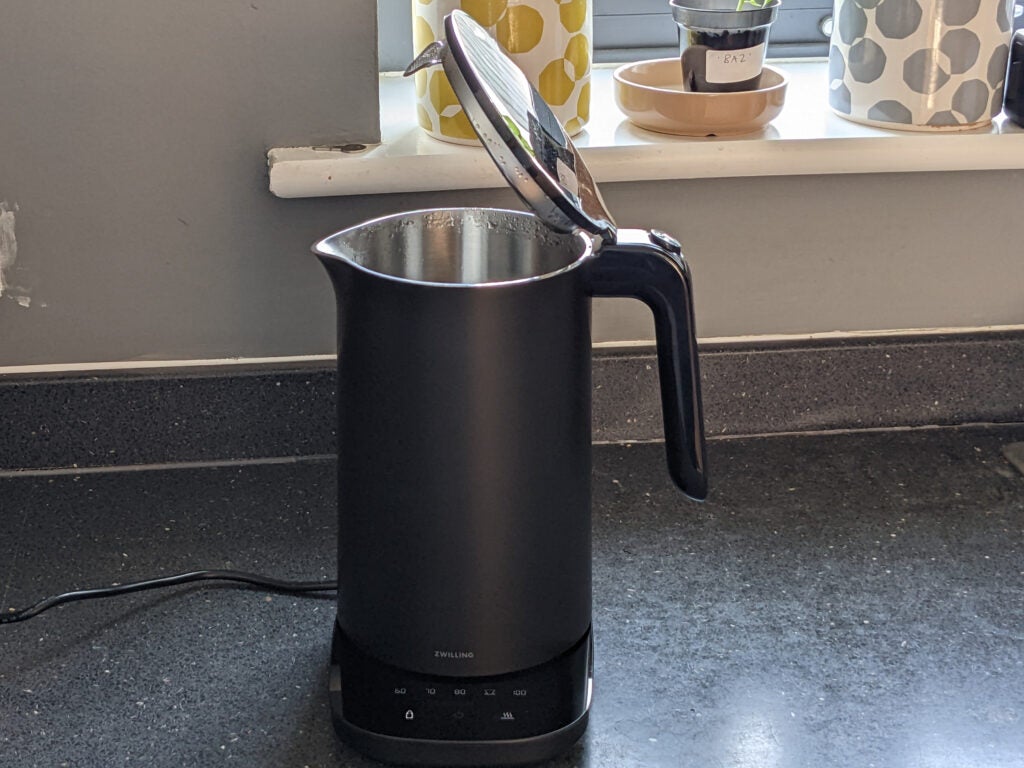Zwilling Enfinigy Electric Kettle Pro Review
A gorgeous example of modern, fuss-free design


Verdict
The Zwilling Enfinigy Electric Kettle Pro is a gorgeous example of modern, fuss-free design. It’s full of great features, and is quieter and safer to handle than most other kettles. It’s a shame, then, that it’s not especially fast or efficient.
Pros
- Looks stunning
- Multiple temperatures
- Safer, dual-wall construction
Cons
- Slow to boil
- Not especially efficient
Availability
- UKRRP: £129
- USARRP: $120
- Europeunavailable
- CanadaRRP: CA$200
- Australiaunavailable
Key Features
- StyleSleek, sparse and practica, this is how jug kettles should be.
- Maximum capacityThis kettle takes 1.5-litres of water maximum.
- Temperature selectionSelectable between 60°C, 70°C, 80°C or 100°C
Introduction
If you want the best looking kettle available, the Zwilling Enfinigy Electric Kettle Pro has to be in with a shout.
Available in black or steel finishes, it’s a cordless jug kettle with multiple temperature controls and a keep warm feature. All of its controls are in the base, and there’s no clear water gauge, leaving the kettle itself beautifully seamless.
Design and features
- Gorgeous design
- Internal water gauge
- 1.5 litre maximum fill
This really is a gorgeous, modern looking kettle. It’s entirely seamless, having no external water gauge. Open the lid and the inside looks more like a stainless steel jug – its lines are only broken by a temperature sensor in the base, and a stamped level gauge on each side. It’s worth noting that right-handers get a level gauge calibrated in litres, while lefties only get cups. This kettle’s limescale filter is fixed to the lid, rather than its spout, and it doesn’t have a particularly fine mesh.

The Zwilling Enfinigy Electric Kettle Pro is notable for having a dual wall construction, which insulates its outer hull from the full heat of freshly boiled water. It’s extremely effective, with the outside never becoming too hot to handle, even after sitting around with boiling water in it. It’s a great safety feature, but there are other benefits. This is a noticeably quiet appliance, particularly during the early, hissy stages of boiling. It also keeps water hotter for longer.
Underneath, there’s a black base with a polished, blank top panel. Press the power button, and this illuminates to show the available temperatures and features. Choose from 60°C, 70°C, 80°C or 100°C, wait a moment, and the kettle will begin heating to that temperature. It beeps loudly when it’s done.

There are three additional icons. Press the baby bottle for 40°C water, or the coffee cup for a rather precise 93°C – apparently ideal for a fresh brew. There’s also a keep warm feature to maintain the chosen temperature for up to 30 minutes. Each temperature lights up as the water passes through, giving you a rough at-a-glance idea of how hot it is.

This kettle has a 500ml minimum capacity. Although it doesn’t look any smaller than the norm, its maximum capacity is 1.5 litres, rather than the 1.7 litres typical of most full-sized alternatives.

Generally, the Electric Kettle Pro is a delight to use. It pours cleanly, even if you tip it up a bit too steeply when full, and the base is responsive and easily understood. Although it looks great, however, none of the buttons offer any tactile feedback, which could be an issue for people with visual impairments.
I found it frustrating that the base doesn’t automatically switch on when you place the freshly filled kettle on it. It’s also worth noting that, if you remove the kettle before it’s reached the target temperature, it’ll resume boiling when you replace it on the base. At first this seemed annoying, but I realised that it could be a timesaver if you want to pour, say, an instant coffee at 80°C, then have the kettle continue to a full boil for a cup of tea.
Happily, despite the base’s lights and controls, I couldn’t measure any standby power use, even with a power meter that goes down to 0.1W.
Performance
- Comparatively slow to boil
- Not particularly efficient
- Stays warm for ages
While many kettles are rated near the 3 kilowatt (kW) maximum you can draw via a normal 13 amp socket, the Zwilling Electric Kettle Pro gets a significantly less powerful 1.85kW element. That could be good news if you’re somewhere with limited power, but it means that this kettle is slower. It needed two and a quarter minutes to bring 500ml of room-temperature water to the boil – the fastest kettles finish the job in about 75 seconds. Boiling the maximum 1.5 litres took a yawn-inducing five and a quarter minutes – fully two and a quarter minutes longer than the fastest kettle I’ve tested.

In theory, this shouldn’t have a significant bearing on power use – it takes the same amount of energy to heat a given amount of water, regardless of whether it’s done quickly or slowly. In practice, however, this kettle consumed a little more power than most others.
Boiling 500ml of room-temperature water consumed 0.07 kilowatt hours (kWh), while boiling 1.5 litres used 0.16kWh. By comparison, a cheap 3kW plastic kettle used 0.06kWh, and 0.15kWh for the same jobs. That difference probably sounds insignificant, but boil 500ml five times a day and, at today’s 34p per kWh cap, the Zwilling would cost £6 more to run over a year.
A large part of the issue may be that this kettle continues heating water for several seconds after it’s clearly reached a full boil. This makes it slower and a little more energy-hungry than it need be, but only when you’re aiming for 100°C. At the 90°C setting it used just 0.051kWh for 500ml of water. Make coffee, not tea, five times a day and you’d save more than £10 a year.
While it may use more energy getting to a boil, the Zwilling Electric Kettle Pro keeps water hot for longer than most kettles, thanks to its insulating dual-wall design. An hour after boiling, 500ml of water had cooled to 59.1°C, while 1.5 litres was still at a scalding hot 77.3°C – warm enough to make an instant coffee without reboiling at all. By comparison, single-skinned metal kettles might cool to around 73°C in the same test, while coloured metal and plastic examples might dip to 65°C or so. If you needed to reboil after this time, the Zwilling Electric Kettle Pro would use less energy to do it.
Latest deals
Should you buy it?
This is a great choice if you want a stunning, quiet kettle with multiple temperatures
The Zwilling Electric Kettle Pro isn’t the biggest kettle, and you can find faster and more efficient multi-temperature alternatives for less
Final Thoughts
This is a beautiful kettle. I particularly like its minimalist, uncluttered design, and the fact that this doesn’t come at the cost of convenience – it’s still easy to use, unless you really need an externally visible water gauge. With small children in our house, I also appreciate that this kettle’s walls never get more than warm.
It’s a shame that the Zwilling Enfinigy Electric Kettle Pro is slower and not quite as efficient as other kettles I’ve tested. Still, this only really becomes an issue when you’re boiling to 100°C – if you mostly make coffee and specialty teas, this is a very satisfying choice, but the Ninja Perfect Temperature Kettle KT200UK boils faster and has a wider range of temperature settings. Check out other alternatives in our guide to the best kettles.
How we test
Unlike other sites, we test every kettle we review thoroughly over an extended period of time. We use standard tests to compare features properly. We’ll always tell you what we find. We never, ever, accept money to review a product.
Find out more about how we test in our ethics policy.
Used as our main kettle for the review period
We measure the temperature of the water for different settings, and see how well insulated each kettle is by measuring 1-litre of boiled water after 20 minutes.
We boil one litre of water to see how fast the kettle is.
FAQs
It largely depends on what you drink. Black tea should always be brewed with boiling water, but at 100°C the flavour of instant and filter coffees will be spoiled – ideally you want 90-95°C for filter coffee. Green and other specialty teas might need water heated to only 60 or 70°C. Not only will they taste better if you have a multi-temperature kettle, you’ll save money by not bringing the water to a full boil.
It’s 500ml, which is about two regular mug-fulls.





